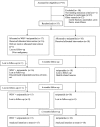The combined effect of Parathyroid hormone (1-34) and whole-body Vibration exercise in the treatment of postmenopausal OSteoporosis (PaVOS study): a randomized controlled trial
- PMID: 31309239
- PMCID: PMC6717187
- DOI: 10.1007/s00198-019-05029-z
The combined effect of Parathyroid hormone (1-34) and whole-body Vibration exercise in the treatment of postmenopausal OSteoporosis (PaVOS study): a randomized controlled trial
Abstract
Treatment effects of combining teriparatide and whole-body vibration exercise (WBV) vs teriparatide alone in twelve months were compared using bone mineral density (BMD), bone microarchitecture, and bone turnover markers. We found an increased effect in lumbar spine BMD by adding WBV to teriparatide in postmenopausal osteoporotic women.
Introduction: The parathyroid hormone (PTH) analogue teriparatide is an effective but expensive anabolic treatment for osteoporosis. Whole-body vibration exercise (WBV) has been found to stimulate muscle and bone strength in some studies. Animal data demonstrate a beneficial effect on bone when combining PTH with mechanical loading. The aim of this study was to investigate if combining WBV exercise and teriparatide treatment gives additional beneficial effects on bone compared to teriparatide alone in postmenopausal women with osteoporosis.
Methods: The PaVOS study is a randomized controlled trial where postmenopausal osteoporotic women starting teriparatide 20 μg/day were randomized to WBV + teriparatide or teriparatide alone. WBV consisted of three sessions a week (12 min, including 1:1 ratio of exercise:rest). Bone mineral density (BMD) and bone microarchitecture, bone turnover markers, and sclerostin measurements were obtained. Data were analyzed using a linear mixed regression model with adjustment for baseline values or robust cluster regression in an intention-to-treat (ITT) analysis.
Results: Thirty-five women were randomized (17 in teriparatide + WBV group and 18 in teriparatide group). At 12 months, both groups increased significantly in BMD at the lumbar spine. The teriparatide + WBV group increased by (mean ± SD) 8.90% ± 5.47 and the teriparatide group by 6.65% ± 5.51. The adjusted treatment effect of adding WBV to teriparatide was statistically significant at 2.95% [95% CI = 0.14-5.77; P = 0.040]. Markers of bone turnover increased significantly in both groups at three and six months with no significant difference between groups. No other treatment effects were observed in hip BMD, bone microarchitecture parameters, or sclerostin levels in either group.
Conclusion: Twelve months of WBV and teriparatide had a significant clinically relevant treatment effect in lumbar spine BMD compared to teriparatide alone in postmenopausal osteoporotic women. ClinicalTrials.gov :(NCT02563353).
Keywords: postmenopausal osteoporosis; randomized controlled trial; teriparatide; whole-body vibration.
Conflict of interest statement
None.
Figures

References
-
- (1994) Assessment of fracture risk and its application to screening for postmenopausal osteoporosis. Report of a WHO Study Group. World Health Organ Tech Rep Ser 843:1–129 - PubMed
-
- Hernlund E, et al. Osteoporosis in the European Union: medical management, epidemiology and economic burden. A report prepared in collaboration with the International Osteoporosis Foundation (IOF) and the European Federation of Pharmaceutical Industry Associations (EFPIA) Arch Osteoporos. 2013;8:136. doi: 10.1007/s11657-013-0136-1. - DOI - PMC - PubMed
Publication types
MeSH terms
Substances
Associated data
Grants and funding
LinkOut - more resources
Full Text Sources
Medical

